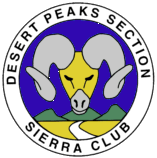Lonesome Minor TrailAug 1996By: Steve Smith |
 |
|
LONESOME MINER TRAIL MAPPING COMPLETED - Inyo Mountains Wilderness From August 7-14, nine BLM Friends of the Inyo Wilderness volunteers continued on their quest to lock in and map the historic alignment for the 40 mile Lonesome Miner Trail (LMT). This was our seventh annual California State Trail Day project and it is gratifying each year to build on what has been accomplished since 1989. Our top priority was dialing in the missing three miles of trail from the Hunter Ridge at 8,200' south to the Bighorn Mine at 7,000'. Other than this segment, we had completely mapped and written up details for the rest of the trail. The trip would also help provide some conditioning for a two and a half week trip through northern Pakistan in September which Brian Webb had put together for the group. Over the years, various groups have fought the steep scree battle of getting from the Bighorn Mine up to the Hunter Ridge. Ron Jones lead a DPS group over the entire LMT three years ago and found this gap to be the primary difficulty in following the entire route. We knew this segment existed since we had seen the trail at both ends but kept loosing it after leaving the Bighorn Mine. Our group was determined to get it located so we allowed ourselves eight days figuring whatever time was left over we would use to explore additional areas. Going in from the Burgess Mine, we climbed New York Butte and then on to Survivor Peak on the Hunter Ridge. This is a prominent peak which with full packs was a slow go up the final 1,000' of steep, loose scree. Once on top of the higher, western summit, its also a challenge to drop down between the twin summits on the steep north side for about 600' to get around the eastern summit and back onto the ridge. From there, the ridge is steep but goes nicely down to where the LMT crosses at 8,200'. This point on the LMT is one of my favorites, perched between Beveridge and Hunter Canyon and we camped there for the next two nights as we worked on the LMT alignment. With nine people and plenty of time, we were able to slowly ferret out the alignment and mark it with rock ducks. At several points, mining activities and rockfalls had taken out key trail turns - once we were by those, we found the central half of this trail segment was easy to follow and had some impressive rocked up switchbacks. By day six we had it all mapped out and then enjoyed being able to stay at the Bighorn Mine for two days. This mine at 7,000' offers great views overlooking Hunter Canyon and down into Saline Valley. There's an old cabin at the site which affords some weather protection and has the date of June 14, 1939 and the names John and Mary etched into the cement floor. Several minor thunderstorms came through while we were camped there and it was a great experience to watch the lightning and changing light patterns across Saline Valley from our vantage point. Running low on water, Tom Budlong and Morgan Irby took a day to backpack up 10 more gallons of water for the group from the Bighorn Spring. For two days, we enjoyed doing some area exploration. A major outing was to check out the remains of an old 1" water pipeline coming steeply up to the cabin and adjacent mining area out of Hunter Canyon. We followed it down for about 1,000' into a side canyon where there was a small spring, water tank and water pump with tools and a can of gas from the 30's - what a great find. While sitting at the cabin, through binoculars, we spotted some well constructed trail on a ridge to the southwest in an area we had never been, a major ridge dropping into Hunter between Survivor Peak and the LMT. We didn't have enough time to follow it out so added it to the list of something to check out in the future. After seven enjoyable days on the east side of the Inyos, we completed our loop trip by hiking the old dozer road back up to the Burgess Mine from the Bighorn Spring. This old road, now closed to vehicles by the Inyo Mountains Wilderness designation, provides an excellent hiking route and good tie in with the LMT. It's great to finally have the complete historic alignment for the LMT now figured out. Whether it is someday maintained or identified for general public use will be determined when the wilderness management plan for the area is written. At least we now have an accurate inventory and details on the LMT and 14 others which the miners from the 1860's through the 1930's put through the rugged Inyo terrain. | ||
| DPS Archives Index | Desert Peaks Section | ||